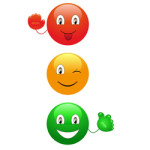 You may remember the childhood game Red Light, Green Light 123. On green the kids run and on red they stop. The child who follows the rules and gets to the stoplight, i.e. the person yelling out red or green, first wins. Simple enough. The adult version of the game occurs in interpersonal relationships. The adult game is more complex, but there is still a premium placed on listening. The key to the adult red light, green light game is to know when to approach, stop, or move with caution when interacting with others.
You may remember the childhood game Red Light, Green Light 123. On green the kids run and on red they stop. The child who follows the rules and gets to the stoplight, i.e. the person yelling out red or green, first wins. Simple enough. The adult version of the game occurs in interpersonal relationships. The adult game is more complex, but there is still a premium placed on listening. The key to the adult red light, green light game is to know when to approach, stop, or move with caution when interacting with others.
Are you a green lighter? Red Lighter? Or yellow lighter? Are you a combination of all three? Below are different colors of the interpersonal stoplight game:
Green Lighters: They are oriented towards connecting with others. Green lighters are friendly, outgoing and often have a warm smile. They listen well and are open to hearing people’s thoughts and feelings. In addition, other people are prone to seeking out green lighters because of their welcoming style. Consequently, socially they have many friends and are often considered likable.
In the stoplight game moving forward when the green light is indicated is highly important. Going forward however, when there is a red light can cause problems. Interpersonally, chronic green lighters may find themselves approaching others when they shouldn’t. For example, opening up to someone who is not trustworthy can be harmful leading to betrayal or emotional pain. Additionally, green lighters who can’t put the breaks on may be prone to saying “yes” to others all the time. This can lead them to feeling as though they are being taken advantage of.
Red Lighters: Ultimately red lighters don’t trust others and may feel socially isolated. They may feel that others are not interested in them and will reject or hurt them. As a result, to avoid rejection they may keep to themselves. They are not prone to smiling or making conversation, which pushes others away; They are perceived as unfriendly and indifferent. Their perception that others are not interested and rejecting may be accurate. Unfortunately, although keeping the red light on all the time may protect red lighters from rejection, or hurt feelings, it can be a recipe for depression and create a self-fulfilling prophecy.
Yellow lighters: There is no yellow light in the child’s game, but it is a common signal interpersonally that adults are aware of. It can be adaptive to move forward with caution when meeting someone or when approaching a new social situation. It can take time to get to know someone and whether you can trust them. Moving too fast can be a problem in dating, in friendships or in business relationships. However, proceeding with caution at a yellow can take the vitality out of many life situations. Often times, if you are too cautious you cannot enjoy or fully embrace an important connection. For example, falling in love is hard to do if your heart is moving ahead slowly, with caution, already prepared to stop.
The Hybrid Color: Many people are a combination of green, red and yellow. Depending on the situation, knowing when to stop, go or to proceed with caution can be extremely important to successfully navigating interpersonal relationships. Listening attentively to yourself and others is key to help you figure out how best to proceed. You have to be your own stoplight. Unlike when you were a child playing the game, as an adult there is no one providing concrete directions.
If you lean more to the red, but would benefit from green this could be something to look into. If you feel like you are stuck in yellow you may consider adding a dash of green to your life.
So what color are you?
